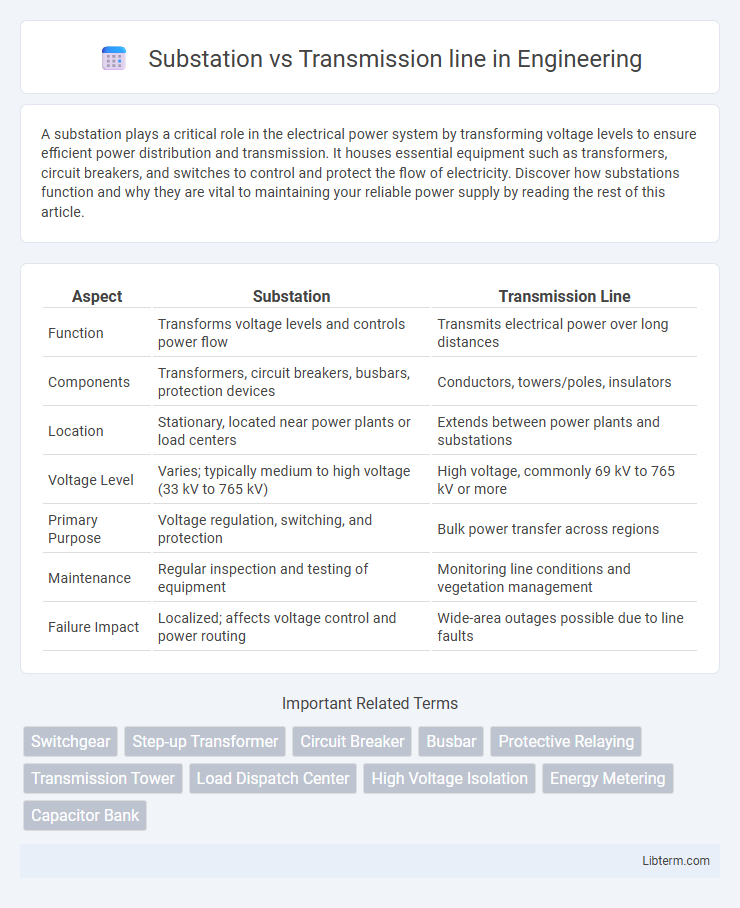A substation plays a critical role in the electrical power system by transforming voltage levels to ensure efficient power distribution and transmission. It houses essential equipment such as transformers, circuit breakers, and switches to control and protect the flow of electricity. Discover how substations function and why they are vital to maintaining your reliable power supply by reading the rest of this article.
Table of Comparison
| Aspect | Substation | Transmission Line |
|---|---|---|
| Function | Transforms voltage levels and controls power flow | Transmits electrical power over long distances |
| Components | Transformers, circuit breakers, busbars, protection devices | Conductors, towers/poles, insulators |
| Location | Stationary, located near power plants or load centers | Extends between power plants and substations |
| Voltage Level | Varies; typically medium to high voltage (33 kV to 765 kV) | High voltage, commonly 69 kV to 765 kV or more |
| Primary Purpose | Voltage regulation, switching, and protection | Bulk power transfer across regions |
| Maintenance | Regular inspection and testing of equipment | Monitoring line conditions and vegetation management |
| Failure Impact | Localized; affects voltage control and power routing | Wide-area outages possible due to line faults |
Introduction to Substations and Transmission Lines
Substations serve as critical nodes in the electrical power grid, transforming voltage levels and facilitating the routing of electricity between generation and distribution systems. Transmission lines, comprised of high-voltage cables or overhead conductors, transport electrical power over long distances from generating stations to substations. Understanding the roles of substations and transmission lines is essential for efficient energy distribution and grid stability.
Definitions: What is a Substation? What is a Transmission Line?
A substation is a facility in the electrical power system where voltage is transformed from high to low or vice versa using transformers, and it plays a critical role in controlling, protecting, and regulating the flow of electricity. A transmission line is a high-voltage conductor or network of conductors that carries electrical power over long distances from power plants to substations. Both components are essential for efficient power distribution, with substations serving as nodes and transmission lines as links within the grid infrastructure.
Core Functions of Substations
Substations serve as critical nodes in the power grid, facilitating voltage transformation, network switching, and system protection to ensure stable electricity flow. Their core functions include stepping up or stepping down voltage levels for efficient transmission and distribution, isolating faults through circuit breakers, and managing power flow to maintain grid reliability. Unlike transmission lines that primarily transport electricity over long distances, substations act as control centers that regulate and optimize power delivery within the network.
Primary Roles of Transmission Lines
Transmission lines serve as critical infrastructure for transporting high-voltage electricity over long distances from power plants to substations. They minimize energy loss through efficient conductors and insulated designs while maintaining grid stability by interconnecting multiple substations. These lines enable the distribution network to operate reliably by balancing load demand and facilitating power flow control.
Key Differences Between Substations and Transmission Lines
Substations function as critical nodes that transform voltage levels and manage power flow in the electrical grid, while transmission lines are the high-voltage conduits that transport electricity over long distances. Substations contain transformers, circuit breakers, and control equipment essential for voltage regulation and system protection; transmission lines consist of conductors and towers designed to minimize energy loss during transmission. The primary difference lies in their roles: substations enable voltage stepping and system control, whereas transmission lines focus on the physical transfer of electricity across regions.
Types of Substations and Their Applications
Substations are categorized into step-up, step-down, distribution, and switching types, each serving distinct functions in electrical grids. Step-up substations increase voltage for efficient long-distance transmission, while step-down substations reduce voltage for safe distribution to consumers. Distribution substations supply electricity to residential or commercial areas, and switching substations facilitate network flexibility by redirecting power flow without altering voltage.
Types of Transmission Lines and Their Applications
Overhead transmission lines, including AC and DC types, are widely used for long-distance electric power transfer due to their efficiency and cost-effectiveness. Underground transmission lines, though more expensive, are applied in urban areas or environmentally sensitive regions to reduce visual impact and enhance safety. Substations act as critical nodes where voltage levels are transformed and transmission lines are connected, enabling efficient integration of diverse transmission types within power grids.
Components Involved in Substations vs Transmission Lines
Substations primarily consist of transformers, circuit breakers, busbars, isolators, and protective relays to manage voltage regulation and ensure safety during power distribution. Transmission lines include conductors, insulators, towers or poles, and grounding systems designed to efficiently transmit electrical energy over long distances. The integration of these components enables the reliable transfer and control of electricity from generation plants to end users.
Importance of Substations and Transmission Lines in Power Systems
Substations serve as critical nodes in power systems, transforming voltage levels, facilitating system protection, and ensuring efficient power distribution to end users. Transmission lines enable the high-voltage transfer of electrical energy over long distances, connecting generation plants to substations and maintaining grid reliability. Together, substations and transmission lines form the backbone of electrical networks, optimizing energy flow and supporting grid stability.
Conclusion: Choosing Between Substation and Transmission Line
Selecting between a substation and a transmission line depends on the specific needs of the power system. Substations are essential for voltage transformation, equipment connection, and system control, while transmission lines focus on long-distance electrical power delivery. Optimal power grid design integrates both components to ensure efficient energy distribution and reliability.
Substation Infographic

 libterm.com
libterm.com